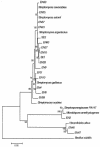Isolation and identification of actinobacteria from surface-sterilized wheat roots
- PMID: 12957950
- PMCID: PMC194995
- DOI: 10.1128/AEM.69.9.5603-5608.2003
Isolation and identification of actinobacteria from surface-sterilized wheat roots
Abstract
This is the first report of filamentous actinobacteria isolated from surface-sterilized root tissues of healthy wheat plants (Triticum aestivum L.). Wheat roots from a range of sites across South Australia were used as the source material for the isolation of the endophytic actinobacteria. Roots were surface-sterilized by using ethanol and sodium hypochlorite prior to the isolation of the actinobacteria. Forty-nine of these isolates were identified by using 16S ribosomal DNA (rDNA) sequencing and found to belong to a small group of actinobacterial genera including Streptomyces, Microbispora, Micromonospora, and Nocardiodes spp. Many of the Streptomyces spp. were found to be similar, on the basis of their 16S rDNA gene sequence, to Streptomyces spp. that had been isolated from potato scabs. In particular, several isolates exhibited high 16S rDNA gene sequence homology to Streptomyces caviscabies and S. setonii. None of these isolates, nor the S. caviscabies and S. setonii type strains, were found to carry the nec1 pathogenicity-associated gene or to produce the toxin thaxtomin, indicating that they were nonpathogenic. These isolates were recovered from healthy plants over a range of geographically and temporally isolated sampling events and constitute an important plant-microbe interaction.
Figures



Comment in
-
Isolation and identification of actinobacteria from plant roots.Appl Environ Microbiol. 2004 Jun;70(6):3794; author reply 3794. doi: 10.1128/AEM.70.6.3794.2004. Appl Environ Microbiol. 2004. PMID: 15184195 Free PMC article. No abstract available.
Similar articles
-
Analysis of the endophytic actinobacterial population in the roots of wheat (Triticum aestivum L.) by terminal restriction fragment length polymorphism and sequencing of 16S rRNA clones.Appl Environ Microbiol. 2004 Mar;70(3):1787-94. doi: 10.1128/AEM.70.3.1787-1794.2004. Appl Environ Microbiol. 2004. PMID: 15006805 Free PMC article.
-
Microbispora tritici sp. nov., a novel actinomycete isolated from a root of wheat (Triticum aestivum L.).Antonie Van Leeuwenhoek. 2019 Aug;112(8):1137-1145. doi: 10.1007/s10482-019-01246-y. Epub 2019 Feb 9. Antonie Van Leeuwenhoek. 2019. PMID: 30739286
-
Mechanism of phosphate solubilization and antifungal activity of Streptomyces spp. isolated from wheat roots and rhizosphere and their application in improving plant growth.Microbiology (Reading). 2014 Apr;160(Pt 4):778-788. doi: 10.1099/mic.0.074146-0. Epub 2014 Jan 15. Microbiology (Reading). 2014. PMID: 24430493
-
Diversity and physiological properties of root endophytic actinobacteria in native herbaceous plants of Korea.J Microbiol. 2012 Feb;50(1):50-7. doi: 10.1007/s12275-012-1417-x. Epub 2012 Feb 27. J Microbiol. 2012. PMID: 22367937
-
Korean indigenous bacterial species with valid names belonging to the phylum Actinobacteria.J Microbiol. 2016 Dec;54(12):789-795. doi: 10.1007/s12275-016-6446-4. Epub 2016 Nov 26. J Microbiol. 2016. PMID: 27888457 Review.
Cited by
-
NaCl Modifies Biochemical Traits in Bacterial Endophytes Isolated from Halophytes: Towards Salinity Stress Mitigation Using Consortia.Plants (Basel). 2024 Jun 12;13(12):1626. doi: 10.3390/plants13121626. Plants (Basel). 2024. PMID: 38931058 Free PMC article.
-
The diversity of bacterial endophytes from Iris pseudacorus L. and their plant beneficial traits.Curr Res Microb Sci. 2022 Apr 12;3:100133. doi: 10.1016/j.crmicr.2022.100133. eCollection 2022. Curr Res Microb Sci. 2022. PMID: 35909614 Free PMC article.
-
Characterization of root-endophytic actinobacteria from cactus (Opuntia ficus-indica) for plant growth promoting traits.Arch Microbiol. 2022 Jan 24;204(2):150. doi: 10.1007/s00203-021-02671-2. Arch Microbiol. 2022. PMID: 35067746
-
Domestication affects the composition, diversity, and co-occurrence of the cereal seed microbiota.J Adv Res. 2020 Dec 17;31:75-86. doi: 10.1016/j.jare.2020.12.008. eCollection 2021 Jul. J Adv Res. 2020. PMID: 34194833 Free PMC article.
-
Isolation and characterization of cyclo-(tryptophanyl-prolyl) and chloramphenicol from Streptomyces sp. SUK 25 with antimethicillin-resistant Staphylococcus aureus activity.Drug Des Devel Ther. 2016 May 31;10:1817-27. doi: 10.2147/DDDT.S101212. eCollection 2016. Drug Des Devel Ther. 2016. PMID: 27330275 Free PMC article.
References
-
- Atlas, R. M. 1993. Alphabetical listing of media, p. 455-462. In L. C. Parks (ed.), Handbook of microbiological media. CRC Press, Inc., Boca Raton, Fla.
-
- Baker, D. D. 1988. Opportunities for autoecological studies of Frankia, a symbiotic actinomycete, p. 271-276. In Y. Okami, T. Beppu, and H. Ogawa (ed.), Biology of actinomycetes. Proceedings of the Seventh International Symposium on the Biology of Actinomycetes. Japan Scientific Societies Press, Tokyo, Japan.
-
- Baker, D. D., J. D. Tjepkema, and C. R. Schwintzer. 1990. The biology of Frankia and actinorhizal plants. Academic Press, Inc., San Diego, Calif.
Publication types
MeSH terms
Substances
LinkOut - more resources
Full Text Sources
Other Literature Sources
Miscellaneous

